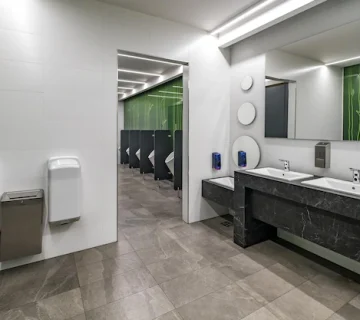Embarking on the journey to purchase and install a ceramic toilet requires careful consideration of various factors, from measuring your bathroom space to understanding the flushing system and evaluating design elements. In this comprehensive guide, we provide essential tips to empower you throughout the entire process, ensuring that your decision aligns with both functionality and aesthetics.
The guide kicks off with insightful tips for buying a ceramic toilet, covering critical aspects such as measuring your bathroom space, understanding flushing systems, evaluating bowl shape and seat height, matching the design to your bathroom style, prioritizing water efficiency, considering cleaning features, setting a realistic budget, checking installation requirements, researching brand reputation, examining warranty details, considering accessibility features, thinking about environmental impact, exploring technology integration, and checking for matching accessories. These tips serve as a roadmap to help you make an informed decision that suits your specific needs and preferences.
Transitioning seamlessly, the guide then delves into the installation process, offering practical tips to guide you through a rewarding DIY project. From gathering the necessary tools and materials to turning off the water supply, removing the old toilet, checking the flange and floor level, installing the wax ring, positioning and securing the new toilet, attaching the water supply, checking for level, securing the toilet seat, turning on the water supply, flushing and checking for issues, sealing gaps, and responsibly disposing of the old toilet—each step is meticulously explained to ensure a successful and satisfying installation.
Whether you’re a seasoned DIY enthusiast or a first-time renovator, these tips aim to provide you with the knowledge and confidence needed to navigate the process of buying and installing a ceramic toilet. As you embark on this journey, we invite you to explore our collection, one of the best ceramic distributors, where quality meets style. Enhance your bathroom experience with the perfect ceramic toilet, combining functionality and style seamlessly.

Tips for Buying a Ceramic Toilet
Purchasing a ceramic toilet involves considering various factors to ensure you make a well-informed decision. Here are essential tips to guide you through the process:
- Measure Your Bathroom Space
– Before shopping, measure the available space in your bathroom. Consider both the width and depth to ensure the toilet fits comfortably without crowding the room.
- Understand the Flushing System
– Different toilets come with various flushing systems. Research and understand the flushing mechanism options, such as gravity-feed, pressure-assisted, and dual-flush systems. Choose one that aligns with your water conservation goals and preferences.
- Evaluate Bowl Shape
– Toilets come with round and elongated bowl shapes. Elongated bowls offer additional comfort, while round bowls are suitable for smaller bathrooms. Choose based on personal preference and the available space.
- Consider Seat Height
– Opt for a comfortable seat height, especially if the toilet will be used by individuals with varying mobility. ADA-compliant or comfort-height toilets are slightly taller and can be more accessible for people with mobility challenges.
- Match the Design to Your Bathroom Style
– Consider the overall design and aesthetics of your bathroom. Choose a toilet ceramic that complements the style, whether it’s modern, traditional, or transitional. Pay attention to details such as tank shape and bowl design.
- Prioritize Water Efficiency
– Look for WaterSense-labeled toilets, indicating they meet specific criteria for water efficiency. Water-efficient toilets contribute to lower water bills and are environmentally friendly.
- Evaluate Cleaning Features
– Consider features that make cleaning easier, such as a concealed trapway and a smooth, glazed surface. Materials that resist stains and are easy to clean can save you time and effort.
- Set a Realistic Budget
– Establish a budget for your ceramic toilet purchase. While premium options may have advanced features, there are also budget-friendly choices that provide reliable performance. Determine your non-negotiable features and find a toilet that fits your financial plan.
- Check Installation Requirements
– Assess the installation requirements of the toilet. Some models may require professional installation, while others are designed for easy DIY installation. Factor in installation costs and your own skill level.
- Research Brand Reputation
– Research the reputation of toilet brands you’re considering. Customer reviews and ratings can provide insights into the reliability and performance of different models. Choose a reputable brand known for quality products.
- Examine Warranty Details
– Check the warranty offered by the manufacturer. A robust warranty demonstrates the brand’s confidence in the durability of its product and provides assurance in case of any issues.
- Consider Accessibility Features
– If you have household members with specific mobility needs, consider toilets with accessibility features such as grab bars, raised seats, or those compliant with ADA standards.
- Think About Environmental Impact
– Assess the environmental impact of the toilet. Some manufacturers prioritize sustainability and eco-friendly practices. Choosing a toilet ceramic with recycled materials or environmentally conscious production processes aligns with eco-conscious values.
- Explore Technology Integration
– If interested, explore toilets with integrated technologies such as bidet functions, heated seats, or touchless flushing. While these features may add to the cost, they can enhance your overall bathroom experience.
- Check Matching Accessories
– Consider whether the toilet comes with matching accessories or can be easily coordinated with other bathroom fixtures. A cohesive bathroom design contributes to a harmonious overall aesthetic.
By keeping these tips in mind, you can navigate the process of buying a ceramic toilet with confidence, ensuring that your chosen fixture meets both your practical needs and aesthetic preferences.

Installation Process | Tips for Installing
Installing a ceramic toilet can be a rewarding DIY project, saving you money and giving you a sense of accomplishment. Here are some practical tips to guide you through the installation process:
- Gather the Necessary Tools and Materials
– Before you begin, ensure you have all the tools and materials required for the installation. This typically includes a wrench, screwdriver, wax ring, bolts, level, and a hacksaw.
- Read the Manufacturer’s Instructions
– Carefully read and follow the manufacturer’s installation instructions provided with the toilet. Each model may have specific requirements, and following the guidelines ensures a proper installation.
- Turn Off the Water Supply
– Before removing the old toilet or starting any installation steps, turn off the water supply to the existing toilet. Flush the toilet to drain as much water as possible from the tank and bowl.
- Remove the Old Toilet
– Disconnect the water supply line and remove the nuts securing the toilet to the floor. Lift the old toilet off the flange, being cautious of any remaining water. Remove the wax ring and clean the flange.
- Check the Flange and Floor Level
– Inspect the flange to ensure it’s in good condition. Check the floor level and make any necessary adjustments to ensure a stable base for the new toilet.
- Install the Wax Ring
– Place a new wax ring onto the flange, making sure it is centered. The wax ring creates a watertight seal between the toilet and the waste pipe.
- Position the Toilet
– Carefully lower the new toilet onto the wax ring, ensuring that the bolts on the flange pass through the mounting holes on the toilet base. Press down firmly to set the wax ring in place.
- Secure the Toilet
– Place washers and nuts onto the bolts, tightening them evenly to secure the toilet to the floor. Be cautious not to overtighten, as this can damage the toilet or the flange.
- Attach the Water Supply
– Connect the water supply line to the fill valve on the bottom of the toilet tank. Hand-tighten the nut, and then use a wrench to give it a quarter turn to secure it.
- Check for Level
– Ensure the toilet is level in both directions. Use a carpenter’s level to make adjustments if necessary. A level toilet prevents issues with flushing and maintains proper drainage.
- Secure the Toilet Seat
– If the toilet seat is not pre-installed, follow the manufacturer’s instructions to attach it securely. Use the provided hardware and a screwdriver to complete this step.
- Turn On the Water Supply
– Turn on the water supply and let the tank fill. Check for any leaks around the base, water connections, and at the fill valve. Tighten any connections if needed.
- Flush and Check for Issues
– Flush the toilet several times to ensure proper flushing and refilling. Check for any unusual sounds or leaks during the process.
- Seal Gaps
– Apply a bead of waterproof caulk around the base of the toilet to seal any gaps between the fixture and the floor. This helps prevent water damage and keeps the installation aesthetically pleasing.
- Dispose of the Old Toilet Responsibly
– If disposing of the old toilet, check local regulations for proper disposal methods. Some municipalities may have specific guidelines for toilet disposal.
By following these DIY installation tips, you can confidently install a ceramic toilet in your bathroom, transforming it with a new fixture that combines functionality and style.




No comment